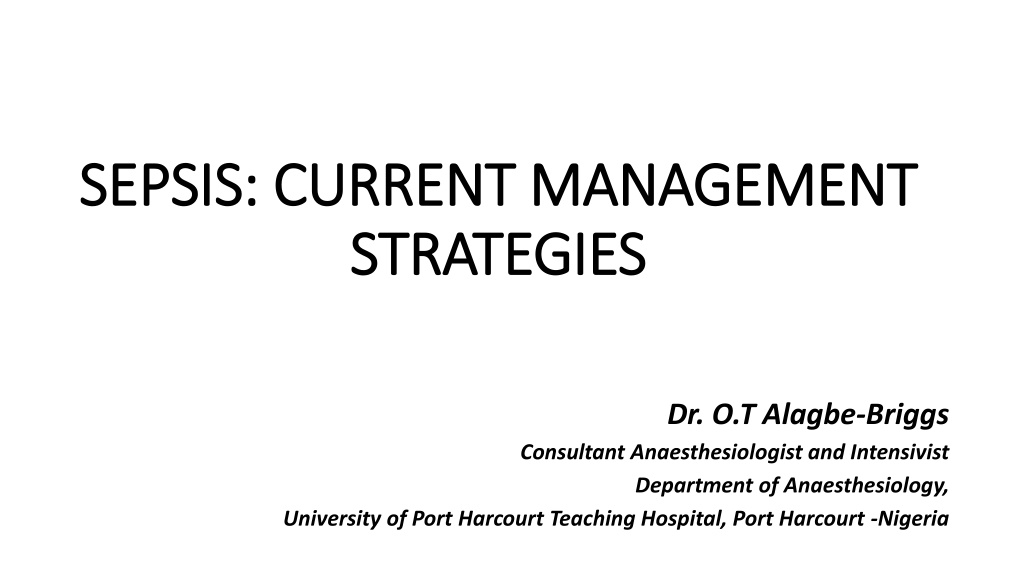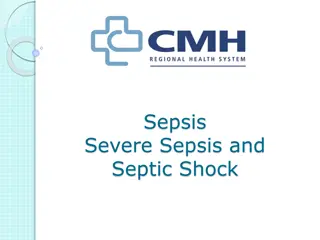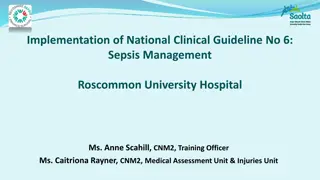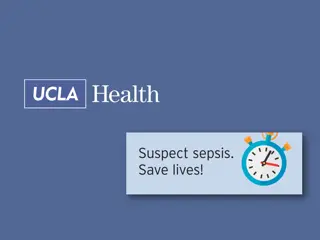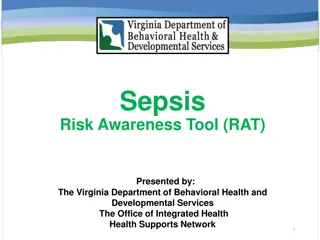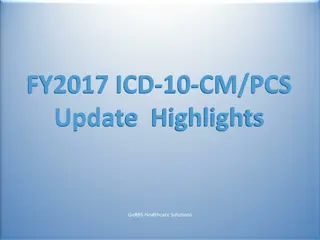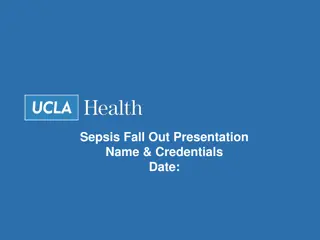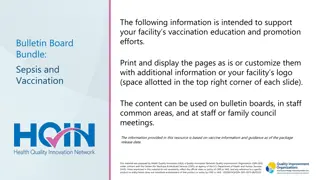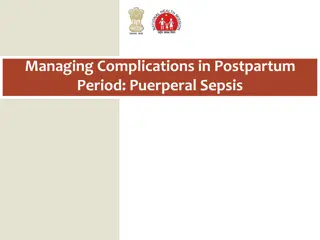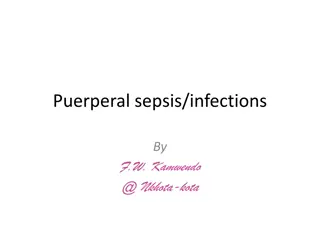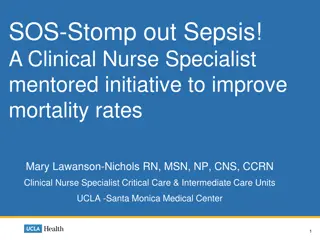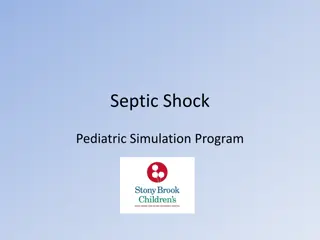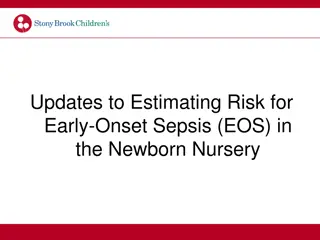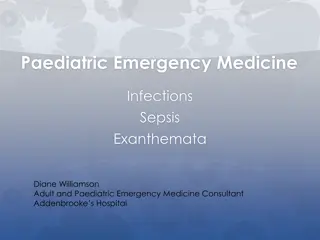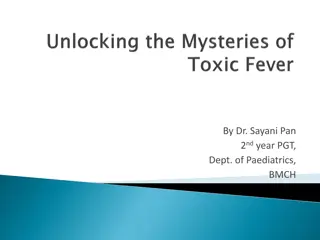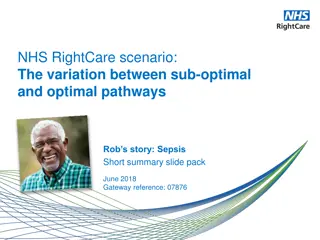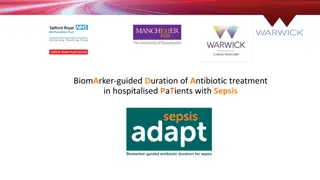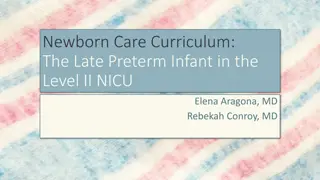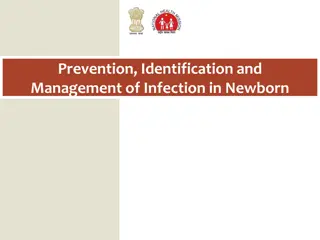Understanding Sepsis: Current Management Strategies and Global Efforts
Sepsis is a life-threatening infectious illness with significant global impact. The World Sepsis Declaration of 2012 underscores the need for improved recognition, prevention, and treatment strategies to address the high burden of sepsis worldwide. Efforts are being made to enhance management guidelines and public awareness to combat this critical health issue effectively.
Download Presentation

Please find below an Image/Link to download the presentation.
The content on the website is provided AS IS for your information and personal use only. It may not be sold, licensed, or shared on other websites without obtaining consent from the author. Download presentation by click this link. If you encounter any issues during the download, it is possible that the publisher has removed the file from their server.
E N D
Presentation Transcript
SEPSIS: CURRENT MANAGEMENT SEPSIS: CURRENT MANAGEMENT STRATEGIES STRATEGIES Dr. O.T Alagbe-Briggs Consultant Anaesthesiologist and Intensivist Department of Anaesthesiology, University of Port Harcourt Teaching Hospital, Port Harcourt -Nigeria
DISCLOSURES DISCLOSURES NONE
OUTLINE OUTLINE INTRODUCTION DEFINITION EPIDEMIOLOGY PATHOPHYSIOLOGY SURVIVING SEPSIS CURRENT GUIDELINES ON TREATMENT OTHER CURRENT CONCEPTS IN TREATMENT CONCLUSION REFERENCES
LEARNING OBJECTIVES LEARNING OBJECTIVES 1. Define Sepsis and evolution in criteria. 2. Describe the key pathophysiologic mechanisms. 3. Know the current guidelines in diagnoses and management. 4. Understand the current scientific thinking for future and the basis.
INTRODUCTION INTRODUCTION Sepsis - common life threatening infectious illness not readily recognized. Both developed and developing world affected equally in incidence. Poorer outcomes in Low and Middle income countries (LMICs): -deficient healthcare and infection prevention plan. -high management costs. Body s response to infection injures its own tissues and organs. - shock, multiple organ failure, disability and death.
World Sepsis Declaration (2012) World Sepsis Declaration (2012) All ages globally but more of young children. Increased also in women peri partum. To achieve UN-SDG 3 (Good Health & Well-Being) -Address burden of Sepsis in HICs and LMICs -Reduction of maternal/child/neonatal mortality & NCD load -Achieve universal, accessible health coverage. Resolution Proposal drafted by the Global Sepsis Alliance (GSA). Adoption of same by the World Health Assembly (WHA).
WHO SEPSIS LOGO WHO SEPSIS LOGO
World Sepsis Declaration (2012) World Sepsis Declaration (2012) GSA recognized sepsis as a global health threat of public concern. UN member states to develop/implement national action plans. To improve prevention, diagnosis and treatment of sepsis by 2030! Slow progress in implementing national plans, even in HICs. Despite high incidence, sepsis largely unknown to the public. World Sepsis Day (WSD) to create awareness - September 13 yearly.
WORLD SEPSIS DAY (WSD) WORLD SEPSIS DAY (WSD) PAST CLIPS Publicise on all media handles, Photo challenge. Conferences, Quiz, PAST CLIPS Family time out, Survivor pic, Leaflets, Pink picnics, Sporting etc
Sepsis - heterogenous syndrome in response to infection. Final common pathway to death from most infectious diseases. A clinical deterioration of common preventable infections (inc. COVID 19). Can develop in patients with chronic and non-communicable diseases. Health threat linked with that from antimicrobial resistance (AMR). Infection prevention, clean water, sanitation, hygiene, vaccination programs and approaches to sepsis recognition/Mx are crucial.
Constant experimental and clinical research with development and refinement over last decades. Improved understanding of origin, pathophysiology, and immunology. Limited translation of findings into course and outcome of syndrome. Specific therapeutic interventions are restricted to non-existent. Evidence-based therapy remains at basic causal & supportive measures. Effectiveness of adjuvant interventions still doubtful. Paradigm shift from pathogen to host response appears promising!
Broadly speaking, improved patient survival depends on: Time of correct diagnosis & initiation of causal, supportive & adjunctive measures. Increasing awareness of sepsis & promotion of quality improvement initiatives. Development of novel diagnostics and interventions.
WHO SEPSIS RESPONSE WHO SEPSIS RESPONSE Public awareness on impacts and estimated global burden. Develop guidance on prevention and management. Support Member States to define and implement standards, establish guidelines, infrastructure, laboratory capacity, strategies and tools for identifying, reducing incidence, morbidity and mortality. Collaborate with UN organizations, partners, international organizations, and stakeholders to enhance treatment, infection prevention and control including vaccinations.
Why high incidence of sepsis? In LMIC s - malnutrition, poverty, access to vaccines and timely treatment. In HICs, non-communicable diseases and complexity of care in all ages. In all countries, AMR and new virulent microorganisms are key!
DEFINITION DEFINITION Progression in definition of Sepsis Consensus statement by American College of Chest Physicians/Society of Critical Care Medicine (SCCM) derived -1990 s Defining Systemic inflammatory response syndrome (SIRS), Sepsis, Severe sepsis and Septic shock (using clinical and laboratory parameters). Emphasizing continuum of acute inflammation and organ dysfunction. But SIRS sensitivity and specificity doubtful. ESICM/SCCM published new consensus definitions (2016): -SIRS and severe sepsis were eliminated. -New definition of Sepsis. -Organ dysfunction definition (change in baseline SOFA score) -Septic shock a subset of sepsis.
DEFINITION DEFINITION Sepsis is a life-threatening organ dysfunction caused by a dysregulated host response to infection. Organ dysfunction: Sequential Organ Failure Assessment (SOFA) score of 2 (ICU). quick SOFA (qSOFA) score of 2 (outside ICU). SOFA, qSOFA, and Systemic Inflammatory Response Syndrome (SIRS) criteria. (Basis of clinical diagnosis - Sepsis-1 criteria in 1992). Subsequent revision supported a SIRS response/restraint from using laboratory measurement of various inflammatory markers (except WBC). Sepsis evaluation based on predisposition, pathogen, host response, organ dysfunction.
Systemic Inflammatory Response Syndrome (SIRS) Systemic Inflammatory Response Syndrome (SIRS) Sepsis-3 separates severe infection from sepsis based on the presence of organ dysfunction - previous criteria for severe sepsis. Differentiating sepsis from SIRS excludes patients with nonspecific changes in inflammatory criteria (trauma, pancreatitis etc). SIRS inflammation - adaptive response to variety of severe clinical insults Describes pathophysiology that may lead to sepsis.
SIRS CONTD. SIRS is characterized by the presence of 2 or more of the following: - Temp >38.10C or <36.00C HR >90b/m, RR >20c/m or PaCo2 <4.3kPa,/32mmHg WBC >12 x 109/L or <4x109/L or >10% immature neutrophils.
SIRS CONTD. SIRS CONTD. SIRS has replaced the previous term sepsis syndrome . Relevant to understand responses to tissue damage from noninfectious sources. SIRS proves insensitive and nonspecific for clinically important outcomes. Sepsis emphasizes the dysregulated response to infection, and establishes organ dysfunction. Sepsis-3 considers criteria to mortality and length of stay in the ICU using large databases.
qSOFA score The ICD s for Sepsis and Septic Shock (Sepsis-Singer et al. 2016) updated previous definitions for sepsis following retrospective study of mortality traits in patients with presumed infection. More understanding of pathophysiology of Sepsis. qSOFA score is a bedside screening tool arising from this study for patients with infection who are not in ICU. Validated by Seymour et al (2017). Clinical suspicion for infection is derived separately. Not a diagnostic tool for sepsis but Sepsis-3 recommends if qSOFA score >2, the full SOFA score including laboratory results should be used.
Variable & Associated Points 0 points = Not high risk 1 point = Not high risk 2 points = High risk 3 points = High risk Not high risk In patients with suspected infection -lower risk for in-hospital mortality. -does not diagnose nor rule out sepsis. High risk In patients with suspected infection -3-14 times higher rates of in-hospital mortality -does not diagnose nor rule out sepsis.
qSOFA qSOFA CHART CHART
SOFA SOFA - - Acute Organ Failure Parameters Acute Organ Failure Parameters
SEPTIC SHOCK SEPTIC SHOCK The Third International consensus definition ( Sepsis-3 ) redefined septic shock as hypotension not responsive to fluid resuscitation , with the added requirement for vasopressors to maintain a MABP >/=65mmHg and serum lactate >2mmol/l. These new definitions were adopted by the 2016 Surviving Sepsis Campaign: International Guidelines for the Management of Sepsis and Septic Shock. A subset of sepsis with profound circulatory and cellular metabolism abnormalities & mortality. .
SUMMARY Sepsis-1: Two or more SIRS criteria in response to the presence of infection. Sepsis-2: Two or more SIRS criteria, along with the presence or suspicion of infection. Additionally, general, inflammatory, hemodynamic, organ dysfunction, and tissue perfusion variables establish criteria to support a diagnosis. Sepsis-3: Presumed or suspected infection along with a change in SOFA score of 2 or more points (or a score 2 if baseline is unknown) in the ICU, or qSOFA score of 2 or more outside the ICU.
Definitions of Sepsis Definitions of Sepsis Category Definition Previous definitions SIRS Temp HR RR WBC >38.1 or <36.0 >90b/m, >20c/m or PaCo2 <4.3kPa,/32mmHg >12 x 109/L or <4x109/L or >10% immature neutrophils. Sepsis SIRS +infection (presumed or proven) Severe Sepsis(SS) Sepsis with evidence of acute organ dysfunction (hypotension, lactic acidosis, u/output, PaO2 /FiO2 ratio, creatinine or bilirubin, thrombocytopaenia, INR) Septic Shock (Sshock Sepsis with persistent hypotension after fluid resuscitation Revised Definitions Sepsis life-threatening organ dysfunction caused by a dysregulated host response to infection Septic Shock Sepsis + vasopressors to maintain MABP >/=65mmHg and serum lactate >2mmol/l despite adequate fluid resuscitation.
EPIDEMIOLOGY EPIDEMIOLOGY The Global Burden of Disease Sepsis Report (2020) ~49 million/year with 11 million deaths > Cancer /ACS deaths. Worldwide, death occurs every 2.8 seconds. Half of all global sepsis cases occurred among children in a 2017 report. Estimates in USA, UK 0.4 -1/1000 of population. Regional disparities in sepsis incidence/mortality - 85.0% in LMIC Accounts for ~27% of ICU admissions in the UK and >30 million globally (mortality ~ 30 -50%). Isa et al - 66% mortality in medical admissions in a Nigerian Hospital. Incidence in F < M but mortality results mixed (sex hormones on innate/adaptive immunity). Black Race incidence (African Americans) > non-whites(relative risk 1.9) Overall mortality has declined from 35% to 18%. Highest quality studies indicate that sepsis is becoming more common but less deadly.
AT RISK POPULATION AT RISK POPULATION Any infection, severe injury, or serious non-communicable disease can progress to sepsis. But higher risk in: older persons, pregnant or recently pregnant women, neonates, hospitalized patients, patients in intensive care units, HIV/AIDS, liver cirrhosis, cancer, kidney disease, autoimmune diseases. Intense alcohol and smoking
Antimicrobial organisms in Sepsis Antimicrobial organisms in Sepsis Bacterial Sepsis Gram positive ( Staphylococcus aureus, epid, Streptococcus pneumoniae ) Gram negative (Pseudomonas spp, Escherichia coli ) Methicillin resistant Staphlococcus aureus (MRSA) Klebsiella , Pseudomonas, and Acinetobacter, Enterobacter
Viral sepsis Clinical presentation similar to bacterial. Underlining immune reaction different. Macrophages (innate immune system) stimulate type I & II interferon. As pro-inflammatory cytokines, these activate neutrophils and lymphocytes as part of the adaptive immune system. A process described in COVID-19 disease. Interferons contribute to organ failure via same septic signaling pathway that results in vascular leakage and hypotension.
Viral sepsis Viruses also downregulate immune response in early phase of invasion resulting in an overreacting immune system and maximal increased pro- inflammatory cytokine level - "cytokine storm". Cytokine storm is probably an expression of this delayed immune response. Before the COVID-19 pandemic, viral sepsis accounted for <5% of sepsis.
Fungal sepsis Fungi - especially candida - are part of normal flora. Occurs with immunosuppression and HAI. Higher mortality due to ?increased level of anti-inflammatory interleukin-10 or different cytokine profile. Microbes can produce toxic metabolites - gliotoxin destroy enterocytes/gut barrier. Virulence also related to ability to switch between yeast and hyphal state making elimination difficult once in the body, as candida can escape leukocytes.
Fungal sepsis Diagnosis challenging in early phase. Positive blood cultures and detection of fungal components can be valuable.(Beta-d-glucan (BDG= a cell wall component of candida). of such). For aspergillus, another main fungal pathogen, positive results of galactomannan, a polysaccharide released by aspergillus is helpful.
Maternal Sepsis Maternal Sepsis WHO estimates global prevalence of 4.4% among live births. Common Pathogens - Escherichia coli, Streptococcus, Staphylococcus Obstetric causes include uterine infection, septic abortion, wound infection, PROM. Incidence of 9 49 per 100,000 deliveries in HIC. Obstetrical critical illnesses severe hemorrhage, amniotic fluid/pulmonary embolism, fatty liver, CHF etc Increasing incidence in USA by 236% over the past decade. Non-obstetric causes pyelonephritis, pneumonia. Major cause of MMM worldwide (11% of deaths). Complications Preterm labour, PROM, fetal abnormalities, stillbirth, perinatal death. LMIC mortality records as high as 50%. General mortality from sepsis (25% 30%), SShock (40% 70%) Management includes fetal status monitoring. Extracorporeal membrane oxygenation used in refractory sepsis. Major cause of ICU admission, morbidity and mortality.
Sepsis in Sepsis in Paediatrics Paediatrics Major cause of morbidity and mortality globally(~10 -30%). Disparities between HIC and LMIC eexist. Reported rates have been ~ 26- 37% in LMIC. Both Gram + and Gram ve organisms have been identified. Septic shock requiring PICU admissions mortality of 17.3% in HIC.
PATHOPHYSIOLOGIC MECHANISMS PATHOPHYSIOLOGIC MECHANISMS CASCADE OF EVENTS Starts with recognition of pathogen-derived molecular patterns (PAMPs, e.g., endo- and exotoxins, lipids, or DNA sequences) or endogenous host-derived danger signals (damage-associated molecular patterns; DAMPs). These activate specific receptors (toll-like receptors -TLR) on the surface of antigen-presenting cells (APCs) and monocytes. Initiation of sepsis via transcription of genes involved in inflammation, cell metabolism, and adaptive immunity. Upregulation of pro and anti-inflammatory pathways results in inflammation, progressive tissue damage and multi-organ dysfunction.
CASCADE OF EVENTS Concomitant immunosuppression due to downregulation of activating cell surface molecules, increased apoptosis of immune cells, and T cell exhaustion, leads to immunoparalysis . Immunoparalysis causes: -nosocomial infections -opportunistic pathogens -viral reactivation. Binding of PAMPs and DAMPs to TLRs on APCs & monocytes causes: -signal transduction -expression of early activation genes, (pro-inflammatory interleukins (IL), e.g., IL-1, IL-12, IL-18, tumor necrosis factor alpha (TNF-a), and interferons (IFNs).
CASCADE OF EVENTS Subsequent activation of: -further cytokines (e.g., IFN-y, IL-6, IL-8) -complement and coagulation pathways -negative feedback (downregulation of adaptive immune system). Net effect on the immunological phenotype (hypo- vs. hyper-responsiveness) remains highly individualized and causes diagnostic difficulties.
CASCADE OF EVENTS In innate immune system, neutrophils are 1st line of defense. Bacterial infections induce Bmarrow release of mature/immature forms. Immature neutrophils show reduced phagocytosis and oxidative burst capacity when activated via PAMPs/DAMPs. Clinical deterioration is associated with the detection of elevated levels of these cells, which is in turn associated with increased spontaneous production and release of neutrophil extracellular traps (NETs) (16, 17).
NETs are diffuse extracellular structures with potential to immobilize a wide range of pathogens (Gram-positive and negative bacteria, viruses, yeasts, protozoa and parasites). NETs release is triggered by cytokines, chemokines, platelet agonists (i.e.,thrombin, ADP, collagen, arachidonic acid) and antibodies. Increased occurrence of NETs due to overproduction/ insufficient degradation has been shown to be associated with hypercoagulation and endothelial damage.
Changes in pro- and anti-inflammatory response of the immune system during the course of sepsis and septic shock. HLA-DR, human leukocyte antigen-D related; IgM/G, immunoglobulin M/G; IL, interleukin; IFN-y, Interferon y; PAMPs, pathogen-associated molecular patterns; TNF-a, tumor necrosis factor alpha; TLR, toll-like receptor.
PATHOPHYSIOLOGIC MECHANISMS PATHOPHYSIOLOGIC MECHANISMS In summary: Invasion by micro-org and their toxins elicit a strong response by the host defenses which is characterized by activation of cellular elements and the plasma protein system. The activated cells are mononuclear cells, macrophages, neutrophils and endothelial cells. These activated cells produce numerous cytokines and mediators. The host defense system also activates the complement, coagulation cascades and the kallikrein-kinin system.
Sepsis Sepsis- -Induced Coagulopathy (SIC) /Role of Endothelium in Sepsis Induced Coagulopathy (SIC) /Role of Endothelium in Sepsis SIC key to sepsis organ dysfunction. Synonymous with disseminated intravascular coagulation (DIC) DIC is characterized by intravascular activation of coagulation with loss of localization due to different causes. Can originate from and cause damage to microvasculature/organ dysfunction . DIC is consumptive coagulopathy. SIC consists of organ dysfunction, platelet count and PT-INR.
Endothelial cells lose anticoagulant function after proinflammatory stimulation and promote coagulation: thrombomodulin and heparan sulfate on cell surface tissue factor (TF). TF expression by pathogen-activated endothelium, adherent tissue factor- loaded monocytes & leukocytic microparticles (activate coagulation cascade). Finally, the pro-inflammatory serine protease thrombin enhances: -endothelial hyperpermeability -adhesion molecule expression -cytokine production.
Complement System Complement System Complement activation products (such as the anaphylatoxins C3a, C4a, and C5a) are elevated in the early stages of sepsis. Physiologically, C5a is associated with the chemotaxis of neutrophils to the site of infection. By binding C5a to the C5a receptor (C5aR), neutrophils develop into migratory cells with the ability to enter inflamed tissue and remove pathogens and debris. Here, PAMPs and DAMPs induce the release of NETs, granular enzymes and reactive oxygen species (ROS) during the oxidative burst, which, in turn, shifts the coagulation balance toward prothrombotic activity, whilst fibrinolysis is inhibited.
Complement System Complement System Disseminated microvascular thrombosis is initiated, and consumption of clotting factors occurs, which is the hallmark of overt DIC. Excessive activation of C5a in sepsis causes aggravation of systemic inflammation, progressive apoptosis of lymphocytes and dysfunction of neutrophils. Overwhelming levels of C5a lead to downregulation of C5aR with adverse effects on the further course of the disease. Homing of neutrophils into the microvasculature, further tissue damage, thrombosis, and ultimately multi-organ failure occur. In a mouse model, the blockade of C5a or C5aR inhibits the development of sepsis.
Significantly increased survival has been shown in models of mild to moderate sepsis of C5aR-deficient mice, accompanied by improved pathogen clearance and largely preserved liver function. Downregulated levels of C5aR correlate with a poor prognosis when C5a levels are simultaneously elevated. Thus, C5a as well as C5aR are key players in many acute and chronic inflammatory conditions, making C5a a highly attractive pharmacological target. The important involvement in sepsis-related inflammation makes both C5a and C5aR promising starting points for the development of novel therapeutic approaches.
Overview of different aspects of immunological dysfunction with details of the affected entities. APC, antigen presenting cell; AZU1, azurocidine 1; CNC,circulating neutrophils count; CTSG, cathepsin G; ELANE, elastase; IFN-y, interferon y; Ig, immunoglobulin; MHCII, major histocompatibility complex II; MPO,myeloperoxidase; PD1, programmed death protein 1; TCR, T cell receptor. Adapted from Bermejo-Martin JF (12) with permission
Complement System With Vilobelimab (anticomplement C5a) and Avdoralimab (anti- receptor C5aR monoclonal antibody; NCT04371367) the respective first-in class monoclonal antibodies are currently tested both in clinical sepsis trials and in COVID 19.
